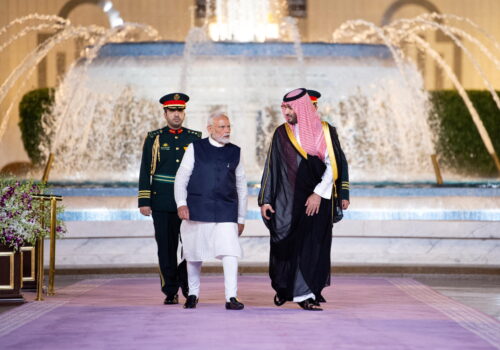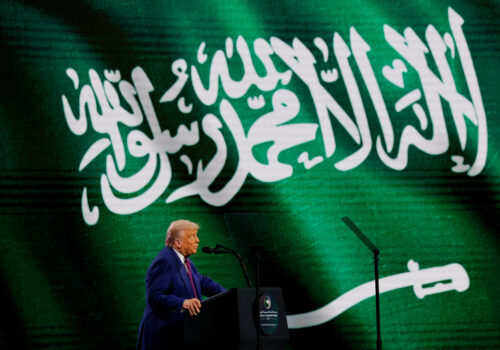China’s basing quest in the Gulf: Pipe dream or strategic reality?
On March 9, 2025, two Chinese People’s Liberation Army Navy (PLAN) vessels joined Iranian and Russian warships in the fifth annual Security Belt drill in the Gulf of Oman. Since 2019, Beijing has joined Tehran and Moscow four times in Security Belt naval drills, testing joint counterterrorism and counter-piracy capabilities in the Gulf of Oman. This reflects China’s broader naval strategy to expand its overseas maritime presence, establish a military footprint, and project power in the Gulf.
Over the past two decades, China’s maritime strategy has evolved from its early, and main, focus on coastal defense to also include far-seas operations. This shift aimed at securing sea lanes critical to energy imports, safeguarding market access, and shaping global maritime norms aligned with its national interests. To this end, China has sought to build global maritime power by leveraging its investments in a vast network of commercial port infrastructure, which has assumed an increasing prominent role in its broader security posture. In parallel, Beijing has significantly invested in expanding the PLAN capabilities and fleet, aiming to transform it into a force capable of sustain power projection far beyond China’s immediate periphery.
The quest for global basing
As China’s overseas commercial interests have expanded, so has its naval footprint. Beijing has sought access and facilities, particularly along Belt and Road Initiative (BRI) routes, leveraging infrastructure investments to advance military reach.
The opening of China’s first overseas military installation in Djibouti in 2017 marked the start of this effort. Notably, the PLAN has been active in the waters off the Horn of Africa since the late 2000s, when Beijing established an independent naval escort taskforce (NEFT) to combat Somali pirates. While the piracy threat has gradually subsided since the mid-2010s, the PLAN has kept a regular naval presence in the region, completing about fourty-seven rotational deployments.
A blend of economic, geopolitical, and strategic interests anchors the PLAN to this maritime region. These include securing energy and trade routes vital to China’s economic system, as well as monitoring Western naval forces en route from the Mediterranean to the Indo-Pacific (Beijing’s main theater of interest).
Capable of housing up to two thousand troops and supporting major naval platforms, the Djibouti base has fuel, weapons, and equipment storage facilities, including an 1,300 foot airstrip. Besides, a base expansion project added a one thousand foot dual-side berth in 2020, making it suitable for aircraft carriers and nuclear submarines. Though officially focused on supporting non-combat tasks (refueling, resupply, and crew rest) of the NEFT, the periodic presence of amphibious ships and attack submarines signals its expeditionary utility.
China is also suspected of operating a facility at Ream Naval Base in Cambodia, officially reopened in April after a three-year, Chinese-sponsored upgrade. The base features infrastructure for high-tonnage warships and lies near the South China Sea and the Strait of Malacca. Despite Cambodian denials of a permanent Chinese military presence, the scale of Chinese involvement and naval activity suggests otherwise.
Commonalities between the Djibouti and Ream naval facilities illustrate three key priorities for a Chinese military foothold in the Gulf region. First, easy access to maritime chokepoints vital to China’s economic and geopolitical interests. Second, the capacity to accommodate big warships and provide advanced fleet support services. Third, a host country sympathetic to China’s foreign policy, or at least willing to engage in a balancing act between Washington and Beijing.
A Gulf military foothold
Strategically positioned near critical global shipping corridors, serviced by modern port infrastructure, and eager to diversify security partners beyond conventional Western interlocutors, most of the Gulf Arab countries meet China’s needs for military expansion. While each Gulf country offers different capabilities, recent developments suggest Chinese planners would find the United Arab Emirates (UAE) or Oman the most suitable for a Chinese naval base.
The UAE
In 2021, US intelligence flagged suspicious Chinese activity at Khalifa Port, Abu Dhabi’s main container terminal, raising alarms about potential military construction. Although the UAE halted the project under US diplomatic pressure. But in a 2023report, The Washington Post, citing top-secret US intelligence documents leaked earlier that year, reported that construction at the suspected Chinese military facility may have resumed. The report did not confirm whether the activity was explicitly military in nature, nor did it provide evidence of continued progress beyond that point.
Since then, there have been no publicly available indications that Chinese military construction is ongoing at the site. Given the strong likelihood that any resumed activity would trigger renewed US pressure, the absence of further disclosures may suggest that the project remains dormant or under close scrutiny.
Beijing’s interest in Khalifa Port is rooted in both commercial and strategic considerations. It is a critical Belt and Road Initiative node, with major Chinese firms involved in port logistics and infrastructure, and Chinese enterprises invested in adjacent industrial zones. Strategically, the port offers China a vantage point for monitoring maritime trade routes and Western military activity. Located under fifty miles from Jebel Ali Port—where the US Navy makes calls for goodwill visits and replenishment—and al-Dhafra Air Base, which hosts US and French forces, Khalifa provides tactical intelligence value.
If Chinese ambitions at Khalifa stall, Fujairah may offer an alternative. As a major bunkering and anchorage hub with direct access to open waters, thus bypassing the vulnerable Strait of Hormuz, Fujairah is strategically appealing. While no public evidence links China to military ambitions there, the port’s capacity to host large warships makes it a potential candidate. However, similar concerns over US sensitivities would factor into Emirati decision-making.
From Abu Dhabi’s perspective, balancing is key. While the UAE seeks to benefit from Chinese investment—especially in logistics and advanced technology—it is acutely aware of the risks such ties pose to its decades-long security partnership with the United States. Abu Dhabi still depends on Washington’s defense guarantees, arms sales, and intelligence cooperation. Any move perceived by the United States as enabling Chinese military access could jeopardize this relationship. As such, the Emirati leadership appears to be walking a careful line, welcoming Chinese commercial ventures but pulling back when such projects threaten to encroach on sensitive security domains.
Oman
Oman also figures prominently in Beijing’s strategic calculus. In 2023, US intelligence alerted former President Joe Biden’s administration to China’s possible plans to establish a military presence in the sultanate. Following Beijing’s established model, seen in Djibouti, of using commercial investment to lay the groundwork for military access, the port of Duqm emerged as a likely candidate. A 2016 agreement between China and Oman granted a fifty-year lease to co-develop the China-Oman Industrial Park, backed by over ten billion dollars in Chinese investments. While several notable initiatives within the park have been launched in recent years, the overall development remains incomplete, with many key projects still underway. Despite these mixed results, the port remains central to China’s long-term economic footprint.
Despite Duqm’s potential, Chinese naval activity suggests Salalah may be the preferred option. Oman’s largest and busiest port, Salalah, handled over 3.3 million twenty foot equivalent units (TEUs) in 2024 and features deep-water berths capable of hosting large naval vessels. While China lacks a commercial presence there, its navy has regularly used Salalah for resupply and port calls since 2009 as part of its Gulf of Aden counter-piracy operations. The Type 054A frigate Honghe most recently made a five-day stop at Salalah for logistical resupply and crew rest.
Oman’s foreign policy approach is shaped by its decades-long tradition of neutrality and quiet diplomacy. While Oman is eager to attract Chinese investment to boost its struggling economy, it is also wary of provoking tensions with the United States, a longstanding security interlocutor. Though less dependent on Washington than Abu Dhabi, Muscat is unlikely to allow Chinese military basing that could imperil its role as a neutral regional broker. Instead, it may prefer to offer logistical access without formal basing commitments.
SIGN UP FOR THIS WEEK IN THE MIDEAST NEWSLETTER
Limited security gains
From the Gulf’s perspective, allowing PLAN access is less about direct military benefits and more about strategic diversification. Chinese basing arrangements could facilitate arms sales and tech transfers aligned with Gulf military-industrial ambitions.
However, the security payoff is limited. During the Houthi anti-shipping campaign, China declined to play an active security role. Rather than joining Western-led efforts to protect Red Sea shipping lanes, Beijing reportedly secured Iranian mediation to avoid Houthi attacks on Chinese vessels. This hands-off approach included suspected passive support: neutral stances at the United Nations, exports of dual-use components, and provision of satellite data potentially used to target US naval assets.
US pushback
The main obstacle to Chinese military basing in the Gulf is US opposition. Both Abu Dhabi and Muscat are integral to the US defense network, with extensive American military assets stationed in the region.
As US-China strategic competition deepens, Washington is unlikely to tolerate a PLAN facility near its forces. Such a presence would facilitate intelligence collection, enable gray zone tactics, and increase operational risks for US assets. Although Chinese bases are unlikely to serve as launchpads for offensive operations in the Middle East at present, the intelligence risks alone justify US resistance. A future shift in Chinese doctrine could make these installations more assertive tools of power projection.
For now, US diplomacy has prevented a Chinese military foothold, as demonstrated by the Khalifa Port incident. Yet the strategic logic behind Beijing’s efforts persists, especially as Gulf states seek broader partnerships. This tension will remain a central issue in US regional diplomacy. Still, host countries control what basing access entails. Washington might engage Gulf partners to establish red lines on PLAN activities, ensuring that a possible Chinese military installation remains below a certain threat threshold for US troops. This could be achieved by preventing the construction of infrastructure and the deployment of Chinese military equipment (high-tonnage warships, advanced air defense systems, and combat aircraft) necessary to project and sustain power in wartime. However, given the intelligence dimension and growing concerns about dual-use technology transfers and espionage, even minimal Chinese military presence may prove unacceptable.
President Donald Trump’s recent visit to the Gulf, including a prominent stop in the UAE, reaffirmed Washington’s commitment to close coordination with regional allies in strategic sectors, such as AI and defense. The proposed AI data campus in the UAE, alongside the intention to establish a comprehensive US-UAE Major Defense Partnership and procurement deals for CH-47F Chinook helicopters and F-16 components, speaks volumes about Washington’s strong willingness to counter Beijing’s growing regional influence. These commitments signal a US strategy aimed at reinforcing economic and military ties with its Gulf partners, thereby dissuading them from letting China establish a regional military footprint, even if it takes the form of lower-tier logistics facility.
An unchanging status quo
Despite growing Chinese naval activity, Gulf states appear reluctant to risk fallout from overt alignment with China. The frictions around Khalifa Port underscore the political cost of appearing to choose sides in the intensifying US-China rivalry.
In the short to medium term, China will likely continue a more discreet approach, favoring “de facto” facilities like Salalah and presenting its maritime posture as benign and commercially driven. Meanwhile, Beijing will deepen ties with regional states through soft military diplomacy and economic integration, avoiding direct confrontation with entrenched Western partnerships.
However, given persistent threats closer to home in the Indo-Pacific, China is unlikely to divert substantial military resources to the Gulf until it feels confident in securing its regional ambitions in Asia. Thus, while the Gulf remains central to China’s long-term maritime aspirations, its near-term military footprint is likely to stay limited, incremental, and calibrated to avoid triggering decisive Western pushback.
Leonardo Jacopo Maria Mazzucco is a researcher who focuses on the security affairs of the Gulf region. He is also an analyst at Gulf State Analytics, a Washington DC-based geopolitical risk consultancy. Follow him on X: @mazz_Leonardo.
Further reading
Tue, Jun 3, 2025
India-Gulf relations are muted—but mobilizing
MENASource By Jonathan Fulton
The depth of Indian-Gulf relations creates a strong foundation for increased India-Middle East integration over the coming decades.
Wed, May 28, 2025
Mickey goes to the Gulf: The UAE’s wish upon a soft power star
MENASource By
In a region often defined by hard power rivalries, Abu Dhabi has chosen to compete through visibility, credibility and imagination.
Fri, May 23, 2025
The Gulf is emerging as Washington’s new strategic anchor
MENASource By Joze Pelayo
The so-called US “Golden Age for the Gulf” is one rooted in strategic utility, equal footing, high-stake deals, and fewer strings.
Image: March 11, 2025, Indian Ocean, Gulf Of Oman, Iran: Chinese People's Liberation Army Navy guided-missile destroyer Baotou (133) during joint military drills in the Indian Ocean and the Gulf of Oman. On the second day of the joint naval drill ''Maritime Security Belt 2025,'' naval forces from Iran, Russia, and China conducted aerial photography exercises and tactical formation maneuvers in the Indian Ocean and the Gulf of Oman. Helicopters from the Iranian Navy and the IRGC are monitoring the three-day exercise. The drill aims to enhance coordination among participating forces and strengthen maritime cooperation. (Credit Image: © Iranian Army Office via ZUMA Press Wire)



